Top 10 animated movies

10. The Tale of the Fox
A sneaky fox plays a series of underhand tricks on his neighbours in the animal kingdom, among them a timorous hare and a gullible wolf. The king of the beasts, a lion, summons him to face charges but the fox proceeds to outwit everyone, including the king himself. When Ladislas Starevich told this tale in the 1930s it was by no means new – versions of the Reynard story had been circulating around Europe for the best part of a millennium – but the means of telling it were utterly novel. Animated over 18 months from 1929 to 1930 (and premiering after a long delay in 1937, in Nazi Berlin), Starevich's beguiling film is often cited as the one of the earliest animated features ever made; it's certainly one of the first features composed of stop-motion animation.
What's striking, eight decades on, is just how sophisticated it is. By 1930, Starevich had been directing stop-motion films for 20 years – he started out making short films using dead insects in what is now Lithuania; after the October revolution, he emigrated to France and continued making films there until the 1960s. The Tale of the Fox is a testament to his great skill as an animator: the anthropomorphised cast (an unscrupulous badger barrister, a courtier cat with eyes for the queen) are remarkably expressive and the film-making brims with invention. In the process of tricking the poor old wolf for the umpteenth time, the fox conjures up a gourmand's vision of heaven that recalls the imaginative flights of Georges Méliès (whose neglected studio in Paris Starevich used after arriving in France). There are extended dream sequences and, at the climax, when the king has been exasperated into all-out military action, a comically protracted siege on the fox's lofty lair involving many pulleys and swinging logs. It's hard to imagine that Wes Anderson, in preparation for The Fantastic Mr Fox, didn't watch Starevich's film with an attentive eye, and pick up a trick or two in the process.Killian Fox
9. Grave of the Fireflies
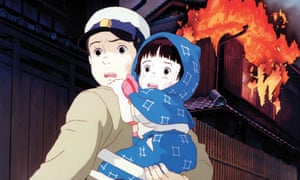
Animation in Japan has a more adult and exalted status than in other parts of the world, in part because they've used it to grapple with darker issues than the likes of Disney-Pixar dare touch: politics, metaphysics and of course the defining event of 20th century Japanese history – nuclear annihilation. Whereas the supernatural, end-of-days millenarianism of Akira (1988) was a slightly insane response to the insanity of instantly losing 200,000 citizens from two bombs, Isao Takahata's Grave of the Fireflies – released the same year as Akira – is something else entirely: a human response to how the war affected two perfectly average children.
The teenage Seita's mission to take care of his baby sister, Setsuko, in an old bomb shelter after their parents are killed is foolhardy and prideful – you can't help screaming "Go back to your wicked aunt!" as he ponders eating frogs to stay alive – but it is a kind of genuine heroism that is not reflected in the actions of the film's selfish grownups. Seita and Setusko watch as the rest of the country slows returns to normal; but their Robinson Crusoe adventure, though doomed, has a joyful purity that damns the hypocritical status quo.
Though Studio Ghibli's animation may be slightly dated now, it also shows how you can draw what you'd struggle to capture on camera: maggots dropping from burn victims, yes, but also the physical details of a little girl's life – rocking from side to side to cope with separation from her mother, bravely conserving her three remaining fruit drops by eating only the sticky shards. It's pathos a four-year-old actor could never convey. You wouldn't think a film about child starvation would be so uplifting, or so beautiful. Chris Michael
8. The Iron Giant

When the new Star Wars films were announced, there was a brief glimmer of excitement when Brad Bird's name was mooted. It's not hard to see why. While Mission: Impossible IV and The Incredibles showed that Bird could pull off style and kinetic set-pieces, 1999's The Iron Giant proved that he's also got the one thing that's been missing from Star Wars for over 30 years: colossal heart.
A loose remake of Ted Hughes's tremendously sad modern fairy tale The Iron Man, The Iron Giant flopped on release. This, plainly, is absurd. The film has been called one of the best non-Disney animations ever made, and the assessment is still hard to argue with.
Hogarth, a young boy, discovers a giant metal robot that has fallen from space, its memory wiped. Hogarth goes about teaching him a uniquely childlike, wide-eyed ideology of the world. The giant learns about good and bad, about death. He becomes a kind of local folk hero, but falls afoul of the military. By the film's end, after Bird has forced Hughes's broader themes of courage and pacifism through his own retro-futurist prism, heartstrings will have been tugged and tears will have been fruitlessly fought back.
A true hidden gem in all regards, The Iron Giant was perhaps a little ahead of its time. Five years after its release, Bird had corralled the might of Pixar into making The Incredibles; a flashier film that shares many of The Iron Giant's core messages. Had he held on for a few more years and given it the full CGI treatment, there's little doubt that The Iron Giant would have conquered all that stood in its way. Stuart Heritage
7. Yellow Submarine
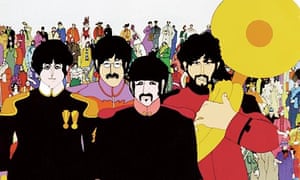
Yellow Submarine was the fourth Beatles film in the space of four years and premiered in the summer of 1968, two years after the band quit touring in a hail of jelly babies (George Harrison's favourite candy, thrown by screaming fans). Seen in the light of the band's growing contempt for their publicity machine, this ambitious animation feature not only builds on the conceit of the the Fab Four's three previous films, in which they played versions of themselves as characters, it takes it to the logical extreme: not only are they not physically in it, they didn't even voice it.
Following their landmark Sgt Pepper album, and pre-empting the Monkees' equally surreal Head by several months, the Beatles somehow managed to smuggle the film's psychedelic aspects past the general public. Indeed, the film was quickly embraced by children, who responded to the simplicity of Lee Minoff's script, which seems remarkably rich considering he later claimed his only influences were repeated plays of the song Yellow Submarine itself and a meeting with Paul McCartney, in which the moptop expressed his hope that the film would contain "a monster".
Pitting the band against music-averse killjoys the Blue Meanies, who attack Pepperland and leave it in a state of frozen limbo, the film was directed by experimental Canadian animation producer George Dunning on a budget of just $1m. Dunning's masterstroke was to install Czech-German illustrator Heinz Edelmann as art director, and it is Edelmann's pop-art creations that stay in the mind, notably the Eleanor Rigby sequence with its bombed-out Liverpool streets and the abstract brainscapes of Lucy in the Sky With Diamonds. It says a lot about the band's careful curation of their own image that Yellow Submarine remains their favourite of their three feature films for United Artists. But it perhaps says more that the following year's Let It Be – the only film to capture the "real" Beatles, on the precipice of a break-up – is currently unavailable on DVD. Damon Wise
6. Persepolis
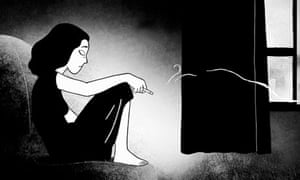
French-Iranian graphic novelist Marjane Satrapi co-wrote and co-directed the film adaptation of her own Persepolis, based on her memories of growing up during the 1979 revolution. Her young on-screen counterpart, Marji, is a spunky, rebellious sprite who worships Bruce Lee, shoots the breeze with God and believes herself to be a prophet. Her family embraces the overthrow of the shah's regime, but Marji realises that Iran is not changing for the better. Like John Boorman's Hope and Glory, which offered the definitive child's-eye view of life during wartime, Persepolis honours its protagonist's trifling concerns. Even with the Iran-Iraq war escalating and missiles destroying the neighbourhood, Marji's prime concern is winning a game of "My uncle has been in prison longer than your father", or scoring a copy of the new Iron Maiden album.
Persepolis brings a lightness of touch to weighty topics, while the drawings capture precisely Marji's bewilderment at her rapidly changing world. When she visits her dissident uncle in a Gothic prison cell rendered in charcoal smudges, the soft, clear lines of her own body make it seem as if she's strayed into a more sinister comic book. At school, headscarves and veils transform Marji and her classmates into rows of Russian dolls, peeking timidly from behind each other's sloping shoulders.
The picture's back-to-basics visual flair remains wonderfully refreshing. The simple black lines, or the blocks of inky darkness inflected with white detail (such as the silhouetted gas masks with two lunar circles for eyes), are both plain and poetic. Satrapi and her co-director, Vincent Paronnaud, make a little go a long way: the dots of snow falling on a sooty Tehran landscape show that you don't need to be David Lean to conjure an evocative sense of place. There's something satisfying, too, about the use of tidy, monochromatic, near-minimalist animation to describe a subject as messy as modern Iran. Ryan Gilbey
5. Chicken Run

Why did the British animators cross the road? To sign a multi-picture deal with Steven Spielberg. Having turned down a similar offer from Disney several years earlier, Aardman Animation, the stop-motion "claymation" studio from Bristol, teamed up with Spielberg's DreamWorks. "It used to be that the best we could hope for — the very summit of our ambitions — was to do something like The Wombles or Paddington Bear," said Peter Lord, who co-directed Aardman's debut feature, Chicken Run, with Nick Park. The Aardman/DreamWorks marriage was dissolved after disappointing returns from subsequent collaborations Flushed Away and The Curse of the Were-Rabbit. But Chicken Run, the first out of the coop, was a hit.
At the very moment that slick, spick-and-span computer animation was threatening to render old techniques obsolete, this movie went boldly against the grain by looking for all the world like it was all made in someone's back yard. It's essentially a PoW film with chickens rather than plucky British soldiers, rubbery beaks instead of stiff upper lips. It revolves around the efforts of Ginger (voiced by Julia Sawalha) and her fellow hens to escape Tweedy's Chicken Farm — a struggle that is given a boost by the arrival of Rocky the rooster (Mel Gibson), who has fled the circus and is recruited to teach the downtrodden hens to fly.
Even in its most ambitious sequences, such as those involving a terrifying pie-making machine, into which chickens are dropped only to emerge at the other end ready for the supermarket shelves, the picture has the earthy, handmade feel consistent with Aardman's earliest shorts. You can feel the care that has gone into it. More than that, you can practically see the thumbprints. RG
4. Spirited Away
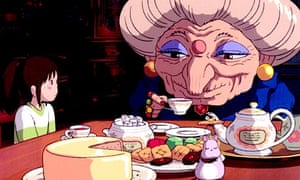
Japanese animator Hayao Miyazaki took his lead from Lewis Carroll to rustle up this delirious rites of passage tale about a small girl's adventures in a bath-house for the gods. One moment 10-year-old Chihiro is bored on the back seat, en-route to a new home. The next, it seems, her parents are pigs, she's forgotten her name and is being asked to scrub down a "stink spirit" that has booked an appointment. Somewhere up ahead sits a dragon and a witch.
In a perfect world, more children's films would be like Spirited Away, which boasts a kind of dream logic, rustling up an outlandish universe which nonetheless runs to its own set of rules. Most film-makers install their supporting players as fixed representations of good and evil. Miyazaki, however, sends them bouncing like pinballs, troublesome and scary, so that the diffident "No Face" blooms into an all-consuming carnivore. Spirited Away has the same skittish, volatile rhythm. It's a magic spell, a booby trap, a helter-skelter to a happy ending.Xan Brooks
3. Up
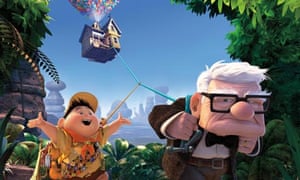
The economy, grace and restraint of Up's four-minute "Married Life" montage, at the very start of the film, may alone be one of animation's finest achievements. At the peak of their flawless streak in the mid-00s, Pixar dared to follow that up with the tender, energetic and boundlessly adventurous story of Carl Fredricksen and Russell, the unlikeliest pair of South American explorers. Up is sillier and more committed to spectacle than some other great animated films, but it's told with Pixar's famously rigorous storytelling, along with precise animation that brings it all – from perfectly cartoonish humans to dramatic vistas – to roaring life.
Up is a story that couldn't exist outside of animation, with a flying house and talking dogs, but even the most realistic moments prove the value of the medium; Carl's weary movements through his creaky house, the vibrant colors the balloons cast on the ground, the cliffs of South America made that much more crooked and wild by being drawn. The film walks a taut line between fantasy and reality, so that the canine fighter pilots feel as important and authentic as Carl's grief. The emotional climax comes as the house is perched at the top of Paradise Falls – the sacrifices and joys of marriage and age made powerfully literal.
Animation is still made in Hollywood almost exclusively for children, which means most big screen cartoons have similar numbing themes of self-acceptance and triumph. Up has that too, but slips in richer, deeper themes from its very start, as much an exploration of the life's disappointments and regrets as of the majestic Paradise Falls. Katey Rich
2. Fantasia
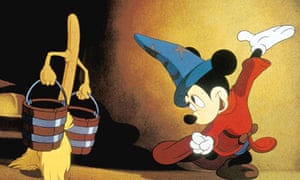
The popular view of Walt Disney is that he was a pragmatist; even the recent quasi-biopic Saving Mr Banks, released by his own company, shows the animation legend handing out pre-printed autographs at his theme park. Yet at the height of his popularity, Disney set out to make a high art concert movie – inspired by the abstract films of New Zealand artist Len Lye – that would take the Silly Symphonies series of the 1930s to a place where "sheer fantasy unfolds". He knew the risks he was taking, telling the New York Times that "if someone didn't break loose with new things, the movies wouldn't be where they are today… Somebody's got to be a damn fool."
Even with today's resources the 1940 Fantasia is a remarkable undertaking, mixing the music of Bach, Tchaikovsky, Schubert and Beethoven with hand-drawn animation from his 700-strong team, using an innovative sound system – Fantasound – that would give the illusion of a full orchestra in the cinema. But Disney's plan was not for the music to accompany the images but the other way round, in perhaps the film's most extraordinary sequence we are invited to Meet The Soundtrack – literally, the film's white magnetic strip gets its own surreal solo as it responds to various instruments.
This movement by movement approach made the studio's distributor, RKO, nervous, so Disney released the film in the roadshow fashion of the silent days, moving from city to city, which proved to be a costly mistake. Regular Disney fans didn't get the non-narrative aspect, and classical music experts hated its literal-mindedness. Over time, though, Disney's intent sank in; once known as his flop, it is now his high watermark. Indeed, its most famous section – Mickey Mouse in The Sorcerer's Apprentice – isn't simply a great piece of 20th century populist art, it is also the apotheosis of its creator's thinking: whoever would have expected Uncle Walt to bring Goethe to the masses? DW
1. Waltz With Bashir
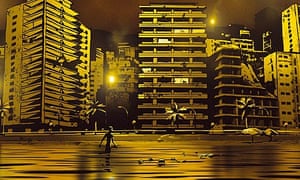
This extraordinary, hallucinatory animation by Israeli film-maker Ari Folman is the story of what he sees as his nation's willed amnesia at the Sabra and Chatila massacres during the Lebanese civil war. The "Bashir" of the title is Lebanon's internationally admired Phalangist leader Bashir Gemayel who was engaged in a tricky diplomatic and strategic dance with Israel, appearing to connive at the Israelis' invasion of his country in 1982 to help drive out the Syrians and the PLO.
Gemayel was assassinated by pro-Syrian forces three months after Israel's invasion, but the killing was wrongly blamed on Palestinians. In the sinister atmosphere of fear, anger and revenge, Israeli troops helped close off the camps in Beirut's Sabra and Chatila districts to facilitate a horrendous retaliatory massacre by Lebanon's Christian militia: up to 3500 Palestinian civilians were slaughtered. Israel was not held directly culpable for this proxy bloodbath; its Kahan Commission accepted a partial or indirect guilt; and this, Folman suggests, is why the historical fact has never been entirely resolved or absorbed in the nation's collective consciousness, and is always threatening to break the surface of memory. It is evidently why he has chosen the medium of animation for the movie, digitally derived from live-action video — like the Rotoscoping techniques of Bob Sabiston.
It is hyperreal and at the same time unreal: a bizarre dreamscape in which reality is morphed into something between two and three dimensions. Planes and surfaces stir and throb with colours harder, sharper, brighter than reality. It looks like one long hallucination, and therefore perfect for the trauma of Folman's recovered memories. This is his acid-trip down memory lane, and he might just have created Israel's very own Apocalypse Now.
It starts with the director's appearance as himself: in middle age, having a beer with a guy who did military service in the Israel Defence Force with him. His friend tells him that he is plagued by a recurring dream about being pursued by savage dogs and says that he believes it has something do with the 1982 Lebanon war. The director himself realises that he has suppressed much of his memory of his own participation of these events. It is all a blur.
So he sets out to track down his old comrades, to ask them what they remember, and so the animation surreally assumes something of oral history and psychoanalysis as well as personal drama. They tell him bizarre and horrifying episodes which pulse out onto the screen: sometimes it is not entirely clear if these episodes were real, or if they are the traumatised dreams which are, however, nonetheless telling the dreamer something important.
And still the director does not know what he remembers about Sabra and Chatila or even if he himself was actually present. As his investigations proceed, he gets nearer and nearer to the truth, and the experience becomes more and more painful, and disorientating.
Waltz With Bashir appeared in 2008, seven years after Richard Linklater's Waking Life, which employed a similar animation technique; it did not become widespread or popular, like the style of Pixar and Dreamworks in their golden decade of digital animation, and it did not become a personal signature, like the "hand-drawn" work of the Japanese master Hayao Miyazaki. But it is distinctive and compelling — and uniquely suited to a unique film. Peter Bradshaw
Gemayel was assassinated by pro-Syrian forces three months after Israel's invasion, but the killing was wrongly blamed on Palestinians. In the sinister atmosphere of fear, anger and revenge, Israeli troops helped close off the camps in Beirut's Sabra and Chatila districts to facilitate a horrendous retaliatory massacre by Lebanon's Christian militia: up to 3500 Palestinian civilians were slaughtered. Israel was not held directly culpable for this proxy bloodbath; its Kahan Commission accepted a partial or indirect guilt; and this, Folman suggests, is why the historical fact has never been entirely resolved or absorbed in the nation's collective consciousness, and is always threatening to break the surface of memory. It is evidently why he has chosen the medium of animation for the movie, digitally derived from live-action video — like the Rotoscoping techniques of Bob Sabiston.
It is hyperreal and at the same time unreal: a bizarre dreamscape in which reality is morphed into something between two and three dimensions. Planes and surfaces stir and throb with colours harder, sharper, brighter than reality. It looks like one long hallucination, and therefore perfect for the trauma of Folman's recovered memories. This is his acid-trip down memory lane, and he might just have created Israel's very own Apocalypse Now.
It starts with the director's appearance as himself: in middle age, having a beer with a guy who did military service in the Israel Defence Force with him. His friend tells him that he is plagued by a recurring dream about being pursued by savage dogs and says that he believes it has something do with the 1982 Lebanon war. The director himself realises that he has suppressed much of his memory of his own participation of these events. It is all a blur.
So he sets out to track down his old comrades, to ask them what they remember, and so the animation surreally assumes something of oral history and psychoanalysis as well as personal drama. They tell him bizarre and horrifying episodes which pulse out onto the screen: sometimes it is not entirely clear if these episodes were real, or if they are the traumatised dreams which are, however, nonetheless telling the dreamer something important.
And still the director does not know what he remembers about Sabra and Chatila or even if he himself was actually present. As his investigations proceed, he gets nearer and nearer to the truth, and the experience becomes more and more painful, and disorientating.
Waltz With Bashir appeared in 2008, seven years after Richard Linklater's Waking Life, which employed a similar animation technique; it did not become widespread or popular, like the style of Pixar and Dreamworks in their golden decade of digital animation, and it did not become a personal signature, like the "hand-drawn" work of the Japanese master Hayao Miyazaki. But it is distinctive and compelling — and uniquely suited to a unique film. Peter Bradshaw
SOURCE: http://www.theguardian.com/film/filmblog/2013/nov/20/top-10-animated-movies-films
No comments:
Post a Comment